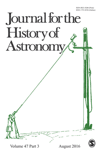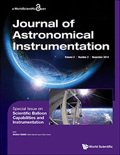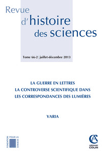
JOURNAL FOR THE HISTORY OF ASTRONOMY
metrics 2024
Exploring the Cosmos of Historical Thought
Introduction
Journal for the History of Astronomy, published by SAGE Publications Ltd, is a distinguished platform for scholars and enthusiasts interested in the evolution of astronomical thought and practice from 1970 to the present. With its ISSN 0021-8286 and E-ISSN 1753-8556, this journal serves the global academic community by publishing rigorous research and insightful articles that explore the intersection of astronomy with history, philosophy, and culture. Although the journal has a more modest impact factor, as indicated by its Q3 classification in Arts and Humanities and Q4 in Astronomy and Astrophysics, it remains a significant resource for understanding the historical contexts and developments of astronomical science. Researchers can access a wealth of information that contributes to enhancing their understanding of the broader implications of astronomical advancements. The Journal for the History of Astronomy provides a unique forum for examining past contributions to the field, engaging readers who seek to appreciate the legacy and ongoing narrative of astronomy particularly in the United States and beyond.
Metrics 2024
 0.12
0.12 0.30
0.30 0.40
0.40 19
19Metrics History
Rank 2024
Scopus
IF (Web Of Science)
JCI (Web Of Science)
Quartile History
Similar Journals

Church History and Religious Culture
Exploring the Intersections of Faith and HistoryChurch History and Religious Culture is a reputable academic journal published by BRILL, focusing on the intricate interplay between history and religious practice. With an ISSN of 1871-241X and an E-ISSN of 1871-2428, this journal serves as a vital platform for scholars and students alike, fostering a deeper understanding of the multifaceted nature of religious traditions through a historical lens. Situated in the Netherlands, the journal is notable for its extensive chronological coverage, having begun its publication journey in 1912 and continuing to present impactful research well into 2024. While it currently holds a Q4 classification in both History and Religious Studies, its commitment to high-quality scholarship ensures relevance and engages a wide readership. Readers are invited to explore an array of research that not only reflects on past narratives but also contributes to contemporary discussions within the fields of history and religious studies, highlighting the enduring significance of faith and belief systems in human society.

Journal of Astronomical History and Heritage
Connecting Celestial Discoveries with Human HistoryWelcome to the Journal of Astronomical History and Heritage, a distinguished publication that delves into the fascinating intersections between astronomical science and its historical context. Published by University Science & Technology China (USTC), this journal aims to promote a deeper understanding of how humanity's understanding of the cosmos has evolved over time. With a focused scope that encompasses the historical narratives of astronomy, this journal serves as a pivotal resource for researchers, professionals, and students in the fields of Astronomy, Astrophysics, and History. Although it is currently categorized in the fourth quartile for Astronomy and Astrophysics and in the second quartile for History, the journal holds an impressive rank in the arts and humanities category, reflecting its 88th percentile standing. The journal, which has aggregated notable works from 2019 to 2024, represents a unique platform for innovative scholarship and discussions related to our astronomical heritage. While offering limited access options, it strives to contribute significant knowledge to the field, fostering collaboration and exchange among scholars dedicated to understanding the past as we explore the universe.

Dynamis
Fostering Insights Through Historical and Philosophical PerspectivesDynamis is a distinguished journal published by EDITORIAL UNIV GRANADA, focusing on the interdisciplinary fields of History and Philosophy of Science as well as Medicine. Since its inception in 1981, this journal has provided a platform for scholarly discussion and exploration of the evolution of scientific thought and medical practices, with a consistent commitment to enriching academic dialogue up to the year 2024. Operating within the Q4 category for both History and Philosophy of Science and Medicine in the 2023 rankings, it holds a unique niche despite its positioning and aims to amplify underrepresented voices and perspectives via rigorous academic analysis. Although not currently an open-access publication, Dynamis continues to serve as a vital resource for researchers, professionals, and students who are keen to understand the historical contexts and philosophical implications in these fields. Its impact within the academic community is reflected in its Scopus rankings, offering valuable insights into the interplay between history, philosophy, and medicine. Situated in beautiful Granada, Spain, Dynamis remains committed to fostering a deeper understanding of the sciences through a historical and philosophical lens.

History of Psychology
Capturing the Narrative of Psychological EvolutionHistory of Psychology, published by the Educational Publishing Foundation of the American Psychological Association, is a leading journal that chronicles the evolution of psychological thought and practice, serving as a vital resource for those interested in the historical dimensions of the discipline. With an ISSN of 1093-4510 and an E-ISSN of 1939-0610, this journal covers a wide array of topics that intersect both history and psychology, offering groundbreaking research and critical analyses from renowned scholars in the field. Given its commendable impact factor and recognition, it holds a prestigious Q1 ranking in History and a Q4 ranking in miscellaneous Psychology according to the 2023 category quartiles. The journal not only enhances scholarly discourse but also makes significant contributions to our understanding of the historical contexts that shape contemporary psychological theories and practices. Researchers, professionals, and students alike will find invaluable insights and context within its pages, making it an essential addition to any academic library. Access options are available through subscription or institutional purchase, facilitating engagement with its rich historical content that ranges from 1998 to 2024.

Journal of the History of the Neurosciences
Delving into the Legacy of Neurological ScienceThe Journal of the History of the Neurosciences, published by Taylor & Francis Inc, is a pivotal scholarly platform dedicated to exploring the rich historical and philosophical dimensions of neuroscience. With an ISSN of 0964-704X and E-ISSN of 1744-5213, this journal serves as a comprehensive resource for researchers, professionals, and students engaged in the intertwined fields of history, philosophy, and neuroscience. Established in 1992 and converging until 2024, it offers a unique lens through which to understand the evolution of neurological thought and practice. The journal holds a Q3 ranking in History and Philosophy of Science and a Q4 in both Neurology and Neuroscience, reflecting its dedication to fostering critical discourse in underrepresented areas. While it is not an open access journal, it remains an authoritative source, enhancing its impact through rigorous peer-review and the dissemination of significant findings. By bridging the gap between past innovations and contemporary challenges, the Journal of the History of the Neurosciences stands as an essential resource for anyone interested in the historical trajectories that have shaped modern neuroscience.

History of Economic Thought and Policy
Illuminating the Evolution of Economic Theory and PracticeHistory of Economic Thought and Policy is a vital journal published by FRANCO ANGELI, dedicated to exploring the intersections of economic theory, historical context, and public policy. With ISSN 2240-9971 and E-ISSN 2280-188X, this journal serves as an essential platform for scholars interested in the evolution of economic ideas and their implications for contemporary policy-making. Operating from Italy, it has established a comprehensive framework for interdisciplinary research in the fields of Economics and Econometrics, History, and Public Administration, although it currently holds a Q4 ranking in these categories according to 2023 metrics. The journal already encompasses multiple converging years from 2018 to 2024, underscoring its commitment to timely contributions to economic discourse. It aims to provide open access to its content, fostering a collaborative environment for researchers, professionals, and students keen on enhancing their understanding of economic thought throughout history. Despite its current challenges in Scopus rankings, with notable positions in arts, humanities, and social sciences, History of Economic Thought and Policy remains a promising outlet for significant and critical discussions surrounding the historical pathways that shape today’s economic policies.

Journal of Astronomical Instrumentation
Illuminating the Cosmos through Innovative InstrumentationThe Journal of Astronomical Instrumentation, published by WORLD SCIENTIFIC PUBL CO PTE LTD, is a pioneering peer-reviewed journal that has established itself as a vital outlet for the dissemination of research in the fields of astronomy and astrophysics, as well as in instrumentation technologies. Since its inception in 2012, this international journal has provided a platform for researchers and practitioners to share their findings, innovations, and insights pertaining to astronomical tools and techniques. With an esteemed Q3 categorization in both Astronomy and Astrophysics and Instrumentation for 2023, it ranks within the top tier of journals in these disciplines, demonstrating its impact and relevance in the scholarly community. Covering a broad range of topics that encompass the design, development, and application of astronomical instruments, the journal also emphasizes technological advancements that enhance observational capabilities. Researchers, professionals, and students alike will find this journal an invaluable resource for staying abreast of current trends and breakthroughs in the field of astronomical instrumentation.

Anos 90
Unearthing Historical Narratives from a Pivotal Decade.Anos 90 is a distinguished journal dedicated to the exploration of historical narratives and cultural phenomena, particularly within the context of Brazil during the tumultuous decade of the 1990s. Published by the Universidade Federal do Rio Grande do Sul as part of its Programa de Pós-Graduação em História, this open access journal has been a vital platform for scholars since 1993, encouraging the dissemination and discussion of historical research that contributes to the understanding of contemporary societal evolution. With an ISSN of 1983-201X and an E-ISSN of 0104-236X, the journal is committed to providing accessible scholarly content to a global audience, thus fostering collaborative research opportunities and academic dialogue. Despite being ranked in the fourth quartile for the History category as of 2023, Anos 90 remains an essential resource for researchers and students seeking in-depth insights into historical interpretation and analysis. The journal serves as a critical juncture for the academic community interested in delving into the complexities of a pivotal era in Brazilian history, making it a significant addition to the field of historical study.

Revue d Histoire des Sciences
Unraveling the Threads of Scientific Thought.Revue d'Histoire des Sciences is a distinguished academic journal published by Armand Colin, focusing on the intricate interplay of history and philosophy within the sciences. Since its inception in 1973, the journal has served as a vital platform for researchers, scholars, and students interested in exploring the historical dimensions of scientific development. With an ISSN of 0151-4105 and an E-ISSN of 1969-6582, this journal is recognized within the academic community, achieving a modest 2023 Scopus ranking of Q3 in History and Philosophy of Science, positioning it within the 41st percentile of its category. The journal offers a prestigious space for rigorous discourse, critical analysis, and innovative research aimed at advancing our understanding of the scientific enterprise's past. While it operates under a traditional access model, the ongoing commitment to rich scholarly content ensures that the contributions will resonate with those dedicated to the intersections of history, science, and philosophy, providing insights into how historical context shapes scientific inquiry and advancement.

Tijdschrift voor Rechtsgeschiedenis-Revue d Histoire du Droit-The Legal History Review
Exploring the Evolution of JurisprudenceTijdschrift voor Rechtsgeschiedenis-Revue d'Histoire du Droit-The Legal History Review is a prestigious academic journal published by BRILL, situated in the Netherlands. With a rich publication history dating back to 1920, this journal serves as a vital resource for scholars and practitioners in the fields of legal history and historical legal studies. Although it currently holds a Q4 ranking in both the History and Law categories, making it a developing journal within its domain, it has been a significant contributor to the discourse surrounding legal traditions, historical context, and the evolution of jurisprudence. Operating within the convergence years of 1920 to 2024, the journal aims to foster scholarly dialogue and promote interdisciplinary research. While it does not offer open access, the unique insights provided within its pages are invaluable for researchers, students, and professionals seeking to enhance their understanding of legal history. By focusing on critical analyses and evidence-based research, the Legal History Review inspires a robust engagement with the past to inform contemporary legal practices and policies.